RESETTING THE

AS THE U AND BYU RE-ENTER CONFERENCE PLAY TOGETHER, BOTH LOOK TO CHANGE THE TENOR OF THE COMPETITION.
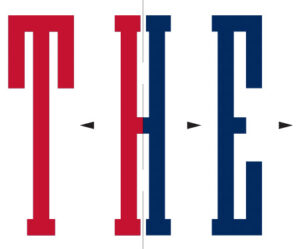 first recorded sporting event between the U and BYU, then known as Brigham Young Academy, was a baseball game ending in a scoreless tie and a bench-clearing brawl. That auspicious start in 1895 set the spark of what would become a heated rivalry. For more than a century, the two neighboring schools had epic matchups in everything from football to swimming and soccer to softball.
first recorded sporting event between the U and BYU, then known as Brigham Young Academy, was a baseball game ending in a scoreless tie and a bench-clearing brawl. That auspicious start in 1895 set the spark of what would become a heated rivalry. For more than a century, the two neighboring schools had epic matchups in everything from football to swimming and soccer to softball.
Temperatures between the two cooled slightly after 2011 when the U entered the Pac-12 and BYU went independent. Now, they’re set for their first conference match-up since that change—BYU entered the Big 12 conference in 2023 and the U will join this summer. As they enter a new era, both schools are looking to reset the rivalry and change its tenor.
“We love a bit of friendly competition at the U,” says U President Taylor Randall HBA’90. “It can help elevate the play of our athletes, and our fans love it. But ultimately, we have incredibly talented students representing schools and the larger community that all of Utah can be proud of.”
The ties between schools are intricate, adds U Athletics Director Mark Harlan. “There is a long and storied history of competition between the two schools, and so much familiarity from program to program among our coaches, staff, and student-athletes,” says Harlan. “That adds a great deal of meaning to those rivalry competitions in all sports, and our fans certainly have a heightened anticipation for those matchups as well.”
Mirroring the U’s dedication to sportsmanship, BYU Athletic Director Tom Holmoe says that BYU appreciates the mutual effort required to sustain the respectful nature of the competition. “This is one of the best rivalries in the country. Having played, coached, and been the AD for 26 years of BYU-Utah games in multiple sports, I can uniquely say that we’ve had something super special here—for players, coaches, and fans—for an entire century,” says Holmoe. “Let’s do all we can to preserve and respect this competitive rivalry, and part of respecting the rivalry is respecting each other.”
Risk and Legacy
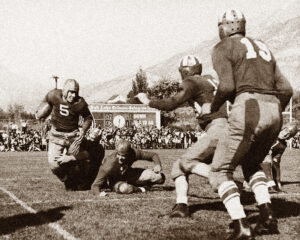
In many ways, you can’t celebrate one team without acknowledging the impact of the other. Let’s look at football, for example. Depending on how you count the series—some don’t include the games played before an annual matchup began in 1922—Utah currently leads 62-34-4, but that doesn’t quite tell the whole story. Take the only time BYU was ranked No. 1 in the nation—it came after beating Utah in 1984, en route to the national championship. On the other hand, Utah busted the BCS twice—clinching invites to the 2004 Fiesta Bowl and the 2008 Sugar Bowl—by defeating BYU.
In 2015, Utah signed wide receiver and kick return extraordinaire Britain Covey BS’21, a diehard BYU fan, who is now one of the NFL’s star punt returners. In 2018, BYU signed Zach Wilson, a Utah fan from Sandy, Utah, who went on to become the No. 2 overall pick in the 2021 NFL draft. And now Wilson’s younger brother, Isaac, a four-star recruit, is on Utah’s roster. Even legendary BYU coach LaVell Edwards MS’60 went to grad school at the U.
The ties don’t stop at football. Consider the leadership of both schools during the 2000s: while Cecil O. Samuelson, a U grad [BS’66 MS’70 MD’70] and Crimson Club founding member, was serving as BYU’s president, Utah’s president was Michael K. Young, a descendant of Brigham Young and a BYU grad [BA, 1973].
That’s just how these two teams tangle.
What Makes a Good Rivalry?
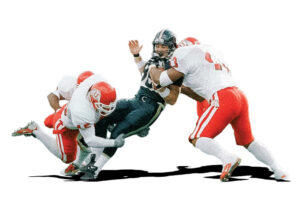
Before the football series took a hiatus in 2021, NFL.com rated the BYU/U matchup as the No. 6 best college football rivalry in the country, noting it is known to “split generations of families.” Familiarity can sometimes breed contempt, noted Bomani Jones in an ESPN article about what makes a good rivalry. “These rivalries are huge because of the recruiting ramifications—particularly when both schools are dependent upon the state’s talent. Plus, fans get bragging rights over millions of people, something that’s extra-special fun,” he wrote.
So, what inspires rivalry? In many cases, it’s a matchup of state schools—think Oregon vs. Oregon State. Others are state school versus nearby private institution—North Carolina vs. Duke, say. And in some cases, religion even comes into play.
But falling into the trap of polarization can be damaging, U Impact Scholar Eboo Patel noted at a recent fireside hosted by the U Latter-day Saint Student Association. The founder and president of Interfaith America said this potentially dangerous situation occurs when people hate others more than they love themselves. “You cannot have a civic life in a diverse democracy if people with diverse identities can’t have conversations,” he remarked.
When tensions are high, take a step back and reflect on the bigger picture, adds Randall. “We’re rivals on the field, but allies in education and partners in building a stronger, more united community,” he notes. “This next chapter in our rivalry is more than a game—it’s a chance to show that competition can coexist with camaraderie and respect. Let’s lead by example.”
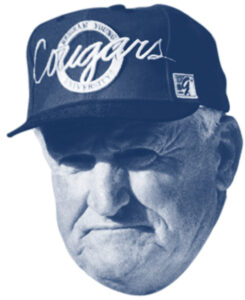
A
LaVell Edwards MS’60 was hired as BYU head coach in 1972. Under his leadership, the Y became known for its high-scoring games and prolific quarterbacks.
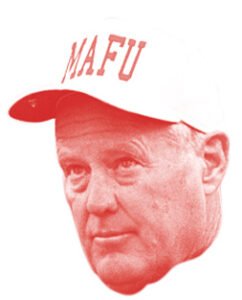
B
The 1990s saw the Utes rise, painting the decade in Utah Red. The turning point came in 1993 after the U hired tenacious coach Ron McBride. That year, Utah clinched a victory in Provo, their first in 22 seasons.
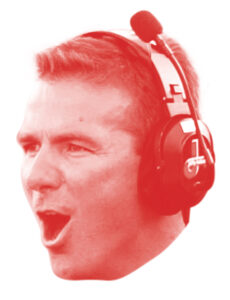
C
Urban Meyer’s 2003 arrival transformed U football, leading the Utes to a historic BCS bowl win in 2004 as the first non-BCS team to do so. His successor, ex-Cougar Kyle Whittingham, clinched a 31-17 win over No. 4 Alabama in the 2008 Sugar Bowl, securing Utah’s status as the season’s only undefeated team.
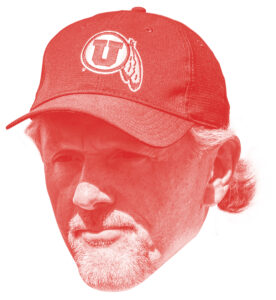
D
The landscape of college football in Utah shifted in the 2010s. The U, under coach Kyle Whittingham, made a monumental move to the Pac-12, while BYU chose to walk the path of a football independent.
A SHARED HEART
Ken Gardner ex’71 bleeds purple. The heart currently pumping blood through the former U basketball star was once in the chest of an ex-BYU football player. In 2013, Nick Longshore was critically injured in an ATV accident and later died in an Idaho hospital. His heart was the perfect match for Gardner. “Thanks to that BYU heart, I’ve been gifted 10 wonderful years of life,” he says. “I’ve walked two daughters down the aisle and seen four granddaughters born. None of that would be possible without Nick, and I am eternally grateful to him and his family.”
Gardner met his donor’s family six months after the operation thanks to some unusual coincidences that led them to reach out. “When Nick passed, his wife was pregnant, and the day I met them I got to hold the four-month-old daughter of the man who gave me a second chance at life,” says Gardner. “I held her close to my chest so she could feel her dad’s heart beating for the first time.”
With his second lease on life, Gardner, who also played professional basketball in France and was named best American player in the league twice, has raised awareness around organ donation and started a nonprofit called Hearts 4 Hearts. “I remember playing BYU each year and all the intense feelings and increased stakes that came with it,” shares Gardner. “But I think I’m the living embodiment of how we’re all part of the same community. And while the rivalry can be fun for fans, and the intensity can be a boost for players, it’s important to remember that at the end of the day, we’re all in this together.”
Editor's note: Kenneth Kay Gardner passed away peacefully at home on May 16, 2024.
RED & BLUE FAMILY HUE
It’s easy to cheer for your team when they’re winning. And it’s easy to love your family when they’re on your side. The challenge arises when those paths diverge. But it comes easier for some—take siblings Bizzy Bowen and Andy Phillips BA’16 MS’16, for example. Bowen was a midfielder on the BYU soccer team while Phillips was a walk-on placekicker for the U.
“Growing up, we only wore BYU gear,” says Bowen. “But when Andy was on that field, you’d never find bigger U fans than me and our family.” Conversely, Phillips was a common sight in Provo—his wife was a Cougarette—and he got to know players, coaches, and BYU staff. “Everyone is so supportive, and I still feel comfortable walking in and saying ‘hi’ to [BYU athletic director] Tom Holmoe in the halls,” adds Phillips.
Their family ties extend even more across both campuses. Their dad played soccer for BYU, and their older brother and mom went to the U for medical school and graduate studies, respectively. But they’ve found a way to navigate the passionate world of college sports with grace, humor, and a whole lot of family support. “Rivalry games are more intense, and they’re not always pretty, but they are a lot of fun,” says Phillips. “For us, it all comes down to recognizing that it’s the passion for the game and support of one another that unites us.” After all, adds Bowen, beneath the jerseys and face paint, we’re really all on the same “team”—even if we occasionally sit on the “wrong” side of the stadium.
Crossing Campus Lines
The bridge between BYU and the U is built on alumni accomplishments that stand out. Here are some highlights.
Merrill J. Bateman BS’60
The U grad served as the 11th president of BYU from 1996-2003.
Norman H. Bangerter
Utah’s 13th governor attended both BYU and the U.
Jeff Judkins BS’84
The former Runnin’ Ute was the winningest coach in BYU women’s basketball history. He’s now the U’s assistant coach of player development.
Willard Marriott BS’26
Co-founded the Marriott hospitality brand with his wife, Alice BA'27, and received an honorary degree from BYU in 1958. BYU’s business school and the U’s library are named in his honor. The U's Center for Dance is named for Alice.
Russell M. Nelson BA’45 MD’47
The President of the Church of Jesus Christ of Latter-day Saints received his undergraduate and medical degrees from the U and was a cardiothoracic surgeon for three decades at the U. He received an honorary degree from BYU in 1970.
Purple Mattress, Co.
This colorful mattress company, named for the material of their product, also reflects the purple of its founding. It was started by Tony Pearce, who attended BYU, and Terry Pearce, who earned an engineering degree from the U in 1973.
Mitt Romney
The Utah senator graduated from BYU in 1971 and was awarded an honorary doctorate of business from the U in 1999.
Ned Siegfried BA’80
One half of law firm Siegfried & Jensen, he graduated from the U before attending law school at BYU.
Wil Stanley
The two-time All-American setter at BYU is now the U’s Women’s Volleyball assistant coach.
Kyle Whittingham
The legendary U football coach graduated from BYU in 1982.
Freddie Whittingham, Jr.
Brother of Kyle, he is now the U tight ends coach. He graduated from BYU in 1992.
Steven C. Wheelwright BS’66
The ninth president of BYU-Hawaii from 2007-2015 graduated from the U.
Olene Walker PhD’87
Utah’s 15th governor, Walker received her undergraduate, master’s, and doctoral degrees from Brigham Young University, Stanford University, and the University of Utah, respectively.
Michael J. Wilkins BS’75 JD’77
The former Utah Supreme Court justice is a U alum and former instructor at BYU’s J. Reuben Clark Law School.
Seth Bracken is editor of Utah Magazine.
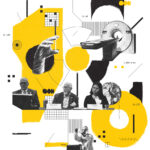
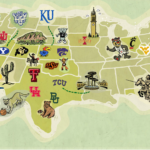
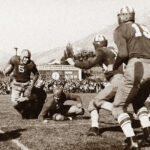


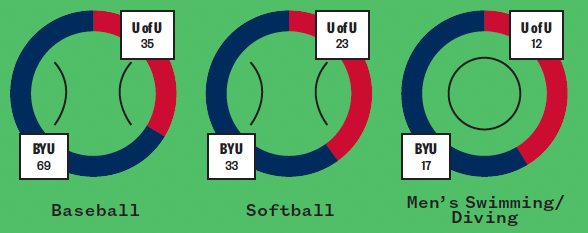
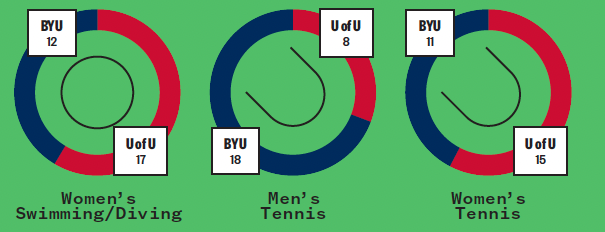
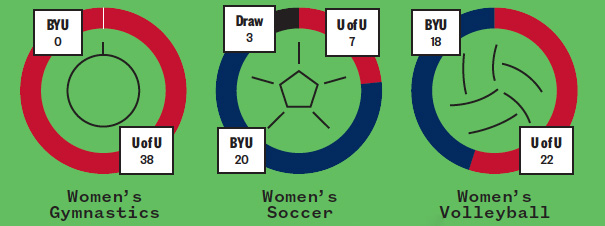




As a BYU and U alum (and primarily BYU fan), I came into this article ready to roll my eyes and feel a little frustrated. But it felt authentic and genuine. Honestly, good on the U for dedicating the space to this. You gained some serious respect from a diehard BYU fan with this one. I know some fans are still going to be awful (on both sides), but it’s encouraging to see this piece.